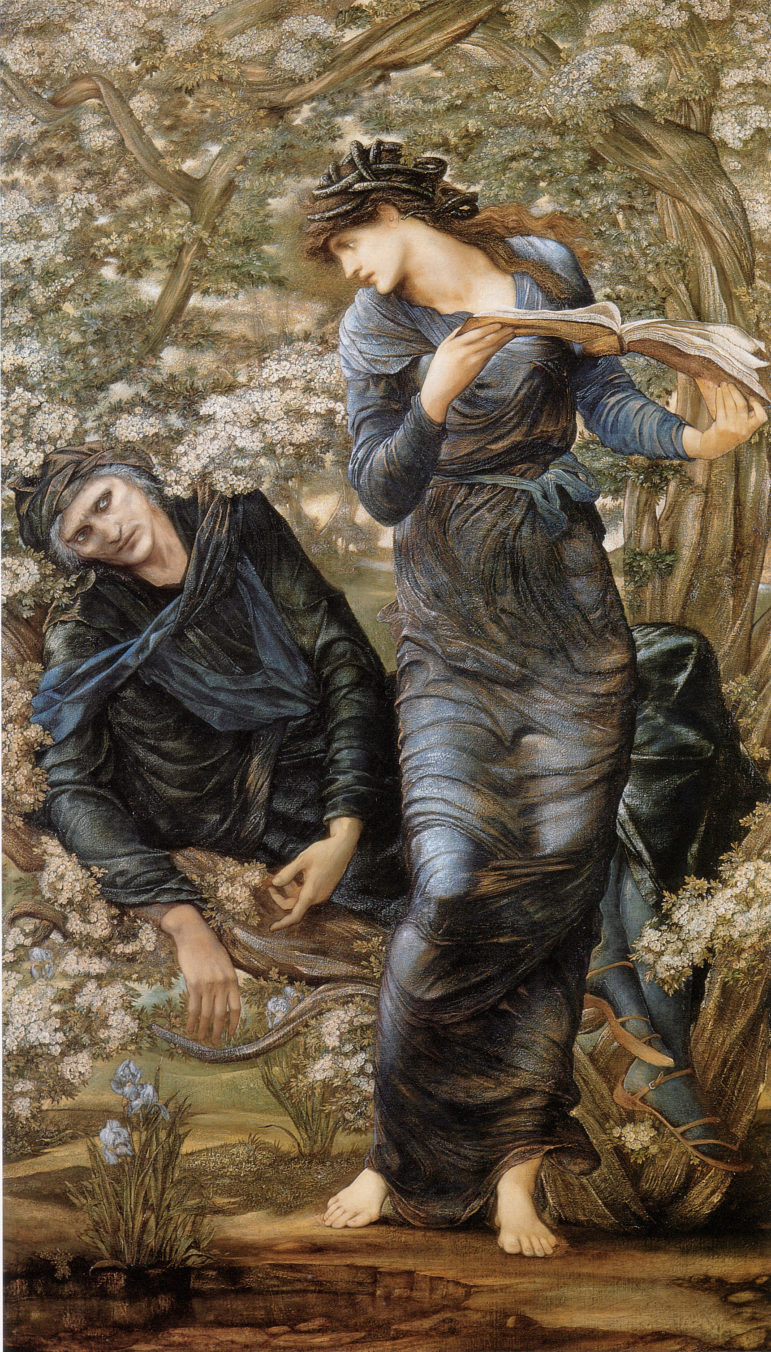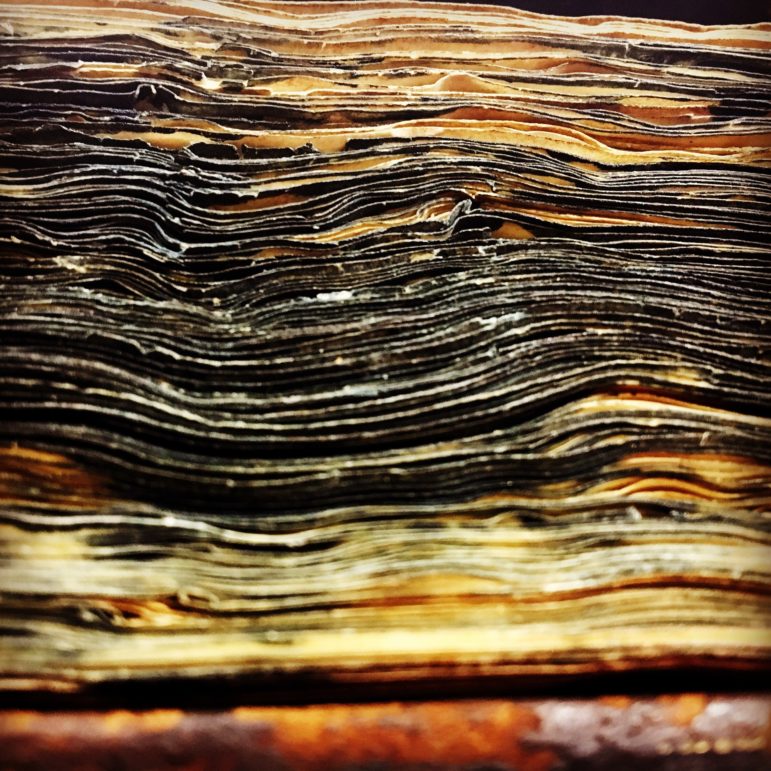BRISTOL, England – Fans of the Arthurian stories were intrigued to learn of the discovery, in 2019, of seven manuscript fragments of the Old French Suite Vulgate du Merlin, as The Wild Hunt reported on in February of 2019.
The manuscripts were found in a set of early printed books in Bristol’s main library, and were essentially cannibalised fragments of an earlier tale, now used for binding. This was relatively common practice in an age where paper and parchment were precious and were often re-used.
In this case, the fragments, which were believed to have been originally published in Strasbourg between 1494 and 1502, may have been recycled as binding due to the more widespread publication and thus the availability of the Morte D’Arthur. Written in French, they were found in the (non-Arthurian) work of a 15th-century scholar Jean Gerson and were probably originally pasted onto the inside of the covers, but were then peeled off and used as part of the flyleaf.
Further research now shows that they are even earlier, dating from 1300-1350, and were written by someone who was English using an ink made of lampblack. The research team discovered an annotation in the margin that dates to the new earlier date range.
Using multi-spectral imaging technology, the team has been able to study parts of the text which are not visible to the naked eye, allowing them also to determine the type of ink used. Professor Andy Beeby of Durham University’s Department of Chemistry has developed a Raman spectrometer specifically for textual analysis.
The fragments seem to have found their way to Bristol via the 17th-century dean and Bishop of Durham, Tobias Matthew. He collected many books and donated a number of them to Bristol public library, which he co-founded in 1613.
Dr. Leah Tether, of the International Arthurian Society, spoke of the Society’s excitement at the time, adding that, “These fragments of the story of Merlin are a wonderfully exciting find, which may have implications for the study not just of this text but also of other related and later texts that have shaped our modern understanding of the Arthurian legend. Time and research will reveal what further secrets about the legends of Arthur, Merlin and the Holy Grail these fragments might hold.”
Dr. Tether’s prediction has proved quite correct; the intervening two years have seen a considerable amount of research conducted on the fragments, which are now revealed to have seen a “more chaste” version of the story of Merlin.
The story itself is probably part of the “Estoire de Merlin.” This was written in Old French and based on a series of texts known as the Vulgate or Lancelot-Grail cycle, on which Sir Thomas Malory based, in turn, “Le Morte d’Arthur.” But now more has been revealed about the tale, which includes Merlin leading the charge into battle with Sir Kay’s dragon standard, which breathes real fire (surely someone is considering a screenplay of this?). It also contains an account of the legendary magician’s sojourn with the enchantress, Viviane.

Beguiling of Merlin – Image credit: By Edward Burne-Jones – Scanned from Wildman, Stephen: Edward Burne-Jones: Victorian Artist-Dreamer, Metropolitan Museum of Art, 1998, ISBN 0870998595, Public Domain
The story fragment says:
“And the girl [Viviane] made Merlin lie down in her lap, and she started to ask him questions. She moved around him, and seduced him again and again until he was sick with love for her. And then she asked him to teach her how to put a man to sleep. And he knew very well what she was planning, but nevertheless, he could not prevent himself from teaching her this skill, and many others as well, because Our Lord God wanted it this way.
And he taught her three names, which she inscribed on a ring every time that she had to speak to him. These words were so powerful that when they were imprinted on her, they prevented anyone from speaking to her. She put all of this down in writing, and from then on, she manipulated Merlin every time that he came to talk to her, so that he had no power over her. And that is why the proverbs say that women have one more trick than the devil.”
Viviane wants to know how to do this skill in order to put her parents to sleep – a big red flag right there, one might think. But Merlin has more than one thing on his mind: he also has to interpret a dream from King Ban’s wife, Queen Elaine, featuring a lion and a leopard.
Dr Tether comments, “In most manuscripts of the better known [version], Viviane casts a spell whereby three names are written on her groin that prevent Merlin from sleeping with her. In several manuscripts of the lesser-known version, these names are written on a ring instead. In our fragments, this is taken one step further: the names are written on a ring, but they also prevent anyone speaking to her. So the Bristol Merlin gets rid of unchaste connotations by removing reference to both Viviane’s groin and the idea of Merlin sleeping with her.”
She adds “Besides the exciting conclusions, one thing that … the Bristol Merlin has revealed is the immeasurable value of interdisciplinary and trans-institutional collaboration, which in our case has forged a holistic, comprehensive model for studying medieval manuscript fragments that we hope will inform and encourage future work in the field. It has also shown us the very great potential of local manuscripts and rare book collections in Bristol, particularly in the central library where there are many more unidentified manuscript fragments awaiting discovery.”
Avid readers will be able to see some of this for themselves in a new book called, “The Bristol Merlin: Revealing the Secrets of a Medieval Fragment,” published by ARC Humanities Press with full-page colour images of the fragments by Don Hooper, an award-winning Bristol-based photographer.
Reaction from UK pagans has been positive, although one commentator remarked that with all the rude bits taken out, no wonder this version of the legend was left on the shelf.
TWH asked Professor Ronald Hutton for his view, and he tells us that nothing about the dating of this new discovery should really change our understanding of the Merlin legend.
The Wild Hunt is not responsible for links to external content.
To join a conversation on this post:
Visit our The Wild Hunt subreddit! Point your favorite browser to https://www.reddit.com/r/The_Wild_Hunt_News/, then click “JOIN”. Make sure to click the bell, too, to be notified of new articles posted to our subreddit.

